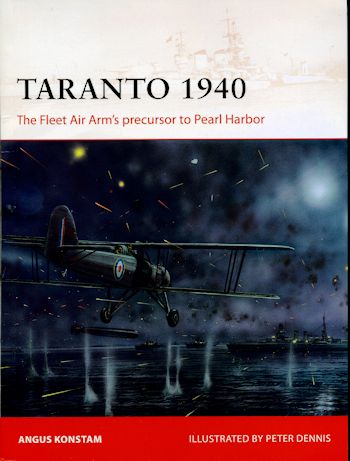Osprey's Taranto 1940
|
Author: |
Angus Constam, illustrated by Peter Dennis |
|
Publisher/Distributor |
Osprey Publishing |
|
Price |
$21.95 MSRP |
|
Reviewer: |
Scott Van Aken
|
|
Notes: |
96 pages, 7¼ x 9¼ inches, softcover
ISBN:978-1-4728-0896-7 |
 In late 1940, the Royal Navy was concerned. Italy had joined the war and the
British had so ticked off the French by sinking their fleet at Oran, that they
were basically alone in the Mediterranean. Thanks to the requirement to keep
much of the British fleet busy doing other things, like convoy escort, keeping
German ships bottled up or chasing them around the oceans that there wasn't much
left over for the folks in the Mediterranean.
In late 1940, the Royal Navy was concerned. Italy had joined the war and the
British had so ticked off the French by sinking their fleet at Oran, that they
were basically alone in the Mediterranean. Thanks to the requirement to keep
much of the British fleet busy doing other things, like convoy escort, keeping
German ships bottled up or chasing them around the oceans that there wasn't much
left over for the folks in the Mediterranean.
On paper, the Italian fleet was formidable and more than a match for the
somewhat antiquated ships based in Alexandria and at Gibraltar. The Royal Navy
only had one carrier, an old and rather small one at the start of the war in
those waters. It was sunk in Norwegian waters during the middle of 1940, leaving
quite a gap in the Mediterranean fleet.
It was felt that the
Italian fleet, based at Taranto in southern Italy, had to be neutralized in
order to allow free passage of supplies to the British fighting in North Africa,
supplies that had to cross the length of the Mediterranean to reach Alexandria
or half of it to supply Malta.
In the late 1930s,
when Italy's aggression in Abyssinia was at its height, the British developed a
plan to use carrier aircraft to attack the Italian fleet, but with the
culmination of that crisis, the plans were put away. Fast forward to late 1940
and the man who drew up those plans was now in a much higher position and able
to influence those British admirals who felt naval aviation was good for little
more that gunfire spotting and reconnaissance. The plans were brought back out
and adjusted for current events.
The Mediterranean
fleet also got the brand new aircraft carrier HMS Illustrious along with its two
squadrons of Swordfish. The British frequently practiced night maneuvers so when
it was decided to attack the Italians in Taranto at night, there was a high
expectation of success, though it was felt that the losses would also be
relatively high.
Taranto had been
heavily built up with numerous anti-aircraft gun positions, barrage balloon
fields and torpedo nets, though even more were planned. Reconnaissance of the
fleet anchorage on an almost daily basis provided the intel needed and so the
plan was put into operation.
In order to help
mask the attack, the British came up with a convoluted mass of operations that
would have made Japanese planning look simple. Unlike the Japanese, this one
actually worked and late at night on 11 November two waves of Swordfish, totally
about 20 aircraft, attacked the Italian fleet.
In this book, the
author has done a superlative job of telling the story of the operation,
including all the build-up and a look at the personalities and equipment
involved. I have to say that I was duly impressed by how he was able to tell the
story of every FAA crew that participated in the attack. The story is so well
told that even knowing how it turned out, the reader (as in I), was
metaphorically on the edge of my seat the whole time.
FIlled with
excellent period photos, some great artwork and maps, the story unfolds before
you. Such was the success of the mission that later the Japanese military
mission in Italy were able to speak to many of the Italians involved. It is felt
that the insights they gained helped them to plan the Pearl Harbor attack a year
latter. In all, it is a superb addition to Osprey's Campaign series and a book
that I can highly recommend to you.
Copyright
ModelingMadness.com October 2015
For more on the complete line of Osprey books,
visit
https://ospreypublishing.com. In the US, it is
Osprey Direct at 44-02 23rd St, Suite 219, Long Island City, NY 11101., where you can
get a catalogue of available books.
If you would like your product reviewed fairly and fairly quickly, please
contact
the editor or see other details in the
Note to
Contributors.
 In late 1940, the Royal Navy was concerned. Italy had joined the war and the
British had so ticked off the French by sinking their fleet at Oran, that they
were basically alone in the Mediterranean. Thanks to the requirement to keep
much of the British fleet busy doing other things, like convoy escort, keeping
German ships bottled up or chasing them around the oceans that there wasn't much
left over for the folks in the Mediterranean.
In late 1940, the Royal Navy was concerned. Italy had joined the war and the
British had so ticked off the French by sinking their fleet at Oran, that they
were basically alone in the Mediterranean. Thanks to the requirement to keep
much of the British fleet busy doing other things, like convoy escort, keeping
German ships bottled up or chasing them around the oceans that there wasn't much
left over for the folks in the Mediterranean.